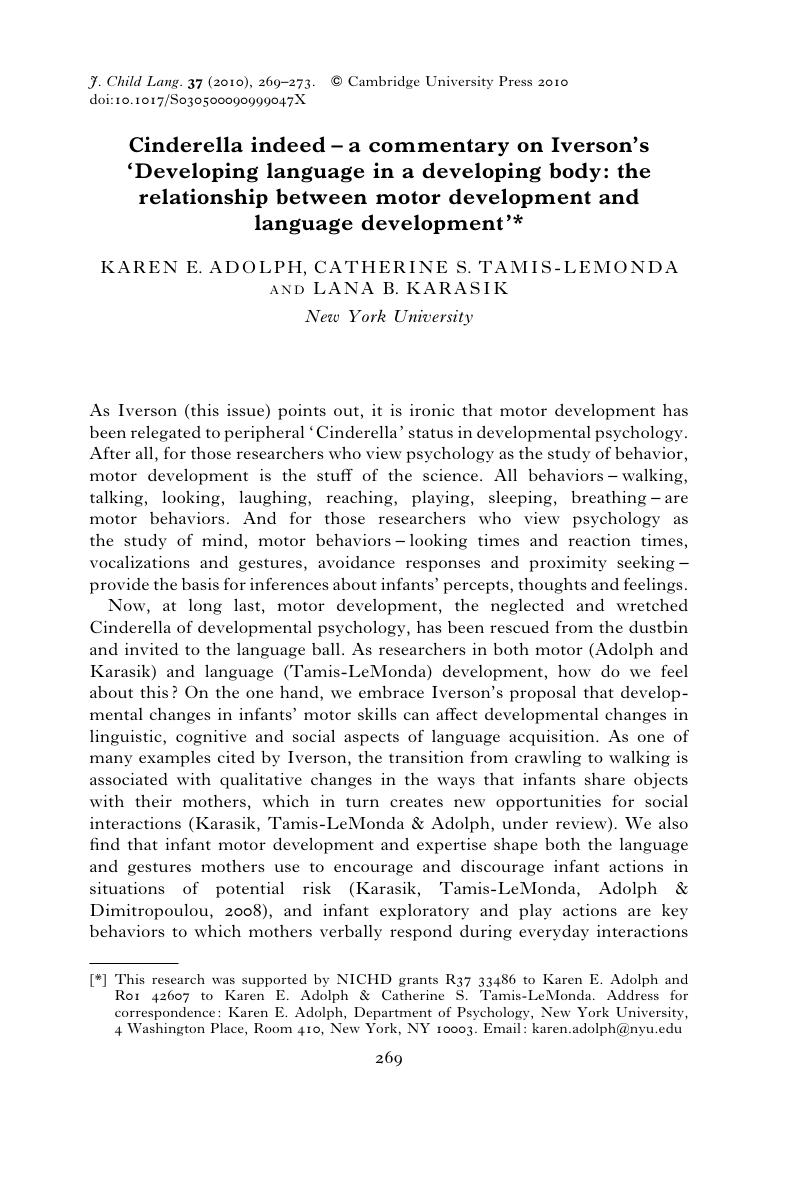Crossref Citations
This article has been cited by the following publications. This list is generated based on data provided by Crossref.
Suttora, Chiara
and
Salerni, Nicoletta
2011.
Maternal speech to preterm infants during the first 2 years of life: stability and change.
International Journal of Language & Communication Disorders,
Vol. 46,
Issue. 4,
p.
464.
Delafield-Butt, Jonathan T.
and
Gangopadhyay, Nivedita
2013.
Sensorimotor intentionality: The origins of intentionality in prospective agent action.
Developmental Review,
Vol. 33,
Issue. 4,
p.
399.
Caçola, Priscila M.
and
Pant, Mohan D.
2014.
Using a Generalized Linear Mixed Model Approach to Explore the Role of Age, Motor Proficiency, and Cognitive Styles in Children's Reach Estimation Accuracy.
Perceptual and Motor Skills,
Vol. 119,
Issue. 2,
p.
530.
Gonzalez, Claudia L. R.
Li, Fangfang
Mills, Kelly J.
Rosen, Nicole
and
Gibb, Robbin L.
2014.
Speech in action: degree of hand preference for grasping predicts speech articulation competence in children.
Frontiers in Psychology,
Vol. 5,
Issue. ,
Anzulewicz, Anna
Sobota, Krzysztof
and
Delafield-Butt, Jonathan T.
2016.
Toward the Autism Motor Signature: Gesture patterns during smart tablet gameplay identify children with autism.
Scientific Reports,
Vol. 6,
Issue. 1,
Kołakowska, Agata
Landowska, Agnieszka
Anzulewicz, Anna
and
Sobota, Krzysztof
2017.
Automatic recognition of therapy progress among children with autism.
Scientific Reports,
Vol. 7,
Issue. 1,
Gonzalez, Sandy L.
Alvarez, Veronica
and
Nelson, Eliza L.
2019.
Do Gross and Fine Motor Skills Differentially Contribute to Language Outcomes? A Systematic Review.
Frontiers in Psychology,
Vol. 10,
Issue. ,
Simeoli, Roberta
Arnucci, Miriana
Rega, Angelo
and
Marocco, Davide
2020.
Movement detection software to enhance autism assessment processes.
p.
1.
Möhring, Wenke
Klupp, Stephanie
Zumbrunnen, Rijana
Segerer, Robin
Schaefer, Sabine
and
Grob, Alexander
2021.
Age-related changes in children’s cognitive–motor dual tasking: Evidence from a large cross-sectional sample.
Journal of Experimental Child Psychology,
Vol. 206,
Issue. ,
p.
105103.
Mohamed, Malikka Begum Habib
and
O’Brien, Beth A.
2022.
Defining the relationship between fine motor visual-spatial integration and reading and spelling.
Reading and Writing,
Vol. 35,
Issue. 4,
p.
877.
McGowan, Timothy
and
Delafield-Butt, Jonathan
2023.
Neonatal Participation in Neonatal Imitation: Narrative in Newborn Dialogues.
Human Development,
Vol. 67,
Issue. 3,
p.
135.
Salazar, Ruby Moye
Rosello, Stacy Sue
and
O’Connell, Mary Ann
2025.
Understanding Autism.
p.
175.
Schiavon, Marta
Burton, Birgitte K
Hemager, Nicoline
Greve, Aja N
Spang, Katrine S
Ellersgaard, Ditte
Plessen, Kerstin Jessica
Jepsen, Jens Richardt M
Thorup, Anne A E
Werge, Thomas
Nordentoft, Merete
and
Nudel, Ron
2025.
Language, Motor Ability and Related Deficits in Children at Familial Risk of Schizophrenia or Bipolar Disorder.
Schizophrenia Bulletin,
Vol. 51,
Issue. 6,
p.
1555.


